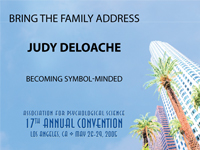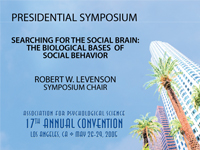History, Her Story
‘That Woman’
By Frank Landy
SHL Landy Jacobs, Inc. USA
2005 APS Annual Convention. I had decided the topic would be national culture and the interaction between culture and human resource practice. At the last minute, I decided to change the topic and present a historical review of the concept of social intelligence, the construct that led the way to the current discussion of emotional intelligence. I had been working on this review for nine months or so and felt this might be a good opportunity to let it see the light of day and get some critical evaluation from colleagues.
Social intelligence research from 1920 through the early 1960s could be described as a largely mindless empirical search for any correlates of a popular but ill-conceived test developed in 1926 (but still administered in the early 60s!). By 1960, most serious psychometricians and differential psychologists (R. L. Thorndike, Cronbach, Anastasi, Wechsler) had dismissed it. But J.P. Guilford had not. He had a long standing interest in emotional expression and had incorporated social intelligence into his comprehensive “Structure of the Intellect.” By the mid-1960s, research was coming out of his group that seemed to confirm that there was actually a construct that appeared to represent a facet of intelligence that might be called “social.”
In my review, I identified this research as a possible watershed for the renewal of serious investigation of social intelligence. But to my amazement, with the exception of a study here or there, this promising line of research seemed to simply disappear by the early 1970s. A key figure on Guilford’s research team was Maureen O’Sullivan. I remembered her name because there had been a well-known History, movie star of that period also named Maureen O’Sullivan (she was “Jane” in all the Tarzan movies between 1933 and 1940, and I wondered vaguely if the parents of Maureen O’Sullivan the psychologist had chosen their daughter’s name because of admiration for the movie star).
In any event, during my presentation, I made a comment about “that woman” (referring to Maureen O’Sullivan), wondering aloud why the social intelligence research enterprise had been abandoned just when it was showing some promise. In the question and answer period following my presentation, I called on a member of the audience who announced in no uncertain terms that she was “that woman” — she was Maureen O’Sullivan! Her comments were both supportive and critical. She was complimentary regarding my historical treatment up to the point that the Guilford group entered the ring. But she felt that I had misrepresented or at least misunderstood the more recent work on emotions and emotional expression — such as the work of Paul Ekman (with whom she now was working).
As any historian knows, you can hardly argue about historical events with someone who was there when you were not. So instead of debating the evolution of the construct in more recent periods, I decided to use the opportunity to ask her some questions about this paradox — why had the research stopped so abruptly? Her answer was a simple one — she said “I had a life to get on with.” I joined the audience in a hearty and empathic laugh — we had all, at one time or another, been faced with that type of decision — should we choose a “real life” or a “research life”? In a discussion with Maureen after the presentation she added substance to the glib answer she had given. There were some non-academic parts of her life that she wanted to attend to and working as a junior researcher in the laboratory of a “legend” who came into the lab every other week to meet with assistants was a challenge of its own. Nevertheless, she did maintain her interest in emotion and the evolution of social intelligence into the construct of person perception as cognitive social psychology matured in the 1970s.
Many years ago, I spent some time interviewing Morris Viteles, the father of modern Industrial/Organizational psychology. He worked with Lightner Witmer at the University of Pennsylvania from 1917 until Witmer’s retirement. At one point, I asked Viteles if any of his research in training had been influenced by the research of Pavlov. He responded “Pavlov was a very nice man; we had several meals together; but I did not use any of his research.” I was stunned to meet someone who had met Pavlov. I don’t know why I was stunned, I just was. When Maureen O’Sullivan announced that she was “that woman,” I had a Pavlov moment. It was a wonderful moment. Incidentally, she assured me her parents had not taken their naming cue from the movie star.
Me, Not Jane
By Maureen O’Sullivan
University of San Francisco
The title of the invited address was “The Pursuit of Emotional Intelligence: A Cautionary Tale.” Since I have been writing and doing research under that rubric for the last several years, off I went to a packed room to hear an elegant and insightful description of R.L. Thorndike’s early article. I had read Thorndike’s article many times, but Frank Landy’s address elaborated on the times in which it was written, speculations about why it was so popular, and comments on whether Thorndike had actually done research on social intelligence, were entrancing. (Give me a break. I am an academic. We get entranced by ideas.)
Then he noted that by 1960, Lee Cronbach’s critiques had essentially killed the person perception field. J.P. Guilford, who had done facial expression work in the 1920s, was not daunted, however. With funding from the Office of Naval Research, he mounted a huge Aptitudes Research Project at the University of Southern California to test his Structure of Intellect model. My slab of Guilford’s hay bale was what he called “behavioral intelligence” and I called “understanding other people.”
Richard de Mille (Cecil B.’s son, more Hollywood!) and I constructed 23 tests using photographs, sounds, cartoons, and realistic drawings by two young men, one of whom become a well-known artist and art critic, Peter Plagens. The project lasted five years, with many waves of pre-tests. Using a battery of 47 (sic!) tests, we demonstrated the five hypothesized factors (O’Sullivan & Guilford, 1975) and published six of the 23 tests. In 1970, Cronbach gave it his Good Psychometric Seal of Approval, noting that at least one of the factors was clearly unique.
Then, as Frank asked: What happened? And as I said: Life happened.
What was the research reality of an individual differences psychologist in the 1970s? Computers that filled buildings, programs that ran 30 variables at a time, videotaping procedures that were clumsy and expensive, high-quality photo reproduction methods that cost a fortune. And an intellectual climate interested in tangible behavior, not in latent attributes. The cutting edge of knowledge about emotion was Stanley Schacter and Jerome Singer (undifferentiated arousal) and Margaret Mead. (It’s all about culture). And, of course, Daniel Goleman [a psychologist/journalist who has written several bestselling books on emotional intelligence in recent years] was still in graduate school.
It took decades of research on facial expression by Silvan Tomkins, Paul Ekman and Carol Izard as well as increased interest in Darwin and evolution to make it exciting to study emotion. By the 1980s, Howard Gardner and Robert Sternberg had hauled understanding others back into respectability by including such abilities in their theories of intelligence. David Kenny and David Funder were looking at person perception accuracy with greater methodological sophistication than their predecessors in the 1950s. And then, in the 1990s, the term emotional intelligence was coined, and the EI juggernaut took off.
So, did I drop the ball? I don’t think so. The zeitgeist was wrong. I didn’t know enough. No one knew enough. But we know much more now than we did. And I never stopped playing. I have been dribbling that understanding- other-people ball down the court, for more than 30 years — doing a study here and a study there, a chapter here and a paper there. Updating norms and redrawing items for some of the behavioral intelligence tests. Working with Ekman and Chris Friesen on facial expression, emotion and lie detection. In the last 10 years, I have gotten sufficiently down-court that I am (almost) ready to slam that ball through the hoop. My colleagues — Paul Ekman and Mark Frank — and I have tested over 14,000 people in order to identify the top 2 percent to 5 percent of accurate lie detectors, a small group of “truth wizards,” who are highly emotionally intelligent people.
So, you see, rumors of my academic death were greatly exaggerated.




APS regularly opens certain online articles for discussion on our website. Effective February 2021, you must be a logged-in APS member to post comments. By posting a comment, you agree to our Community Guidelines and the display of your profile information, including your name and affiliation. Any opinions, findings, conclusions, or recommendations present in article comments are those of the writers and do not necessarily reflect the views of APS or the article’s author. For more information, please see our Community Guidelines.
Please login with your APS account to comment.